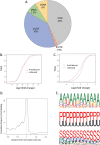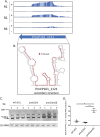The Role and Targets of the RNA-Binding Protein ProQ in the Gram-Negative Bacterial Pathogen Pasteurella multocida
- PMID: 35323048
- PMCID: PMC9017301
- DOI: 10.1128/jb.00592-21
The Role and Targets of the RNA-Binding Protein ProQ in the Gram-Negative Bacterial Pathogen Pasteurella multocida
Abstract
The Gram-negative pathogen Pasteurella multocida is the causative agent of many important animal diseases. While a number of P. multocida virulence factors have been identified, very little is known about how gene expression and protein production is regulated in this organism. One mechanism by which bacteria regulate transcript abundance and protein production is riboregulation, which involves the interaction of a small RNA (sRNA) with a target mRNA to alter transcript stability and/or translational efficiency. This interaction often requires stabilization by an RNA-binding protein such as ProQ or Hfq. In Escherichia coli and a small number of other species, ProQ has been shown to play a critical role in stabilizing sRNA-mRNA interactions and preferentially binds to the 3' stem-loop regions of the mRNA transcripts, characteristic of intrinsic transcriptional terminators. The aim of this study was to determine the role of ProQ in regulating P. multocida transcript abundance and identify the RNA targets to which it binds. We assessed differentially expressed transcripts in a proQ mutant and identified sites of direct ProQ-RNA interaction using in vivo UV-cross-linking and analysis of cDNA (CRAC). These analyses demonstrated that ProQ binds to, and stabilizes, ProQ-dependent sRNAs and transfer RNAs in P. multocida via adenosine-enriched, highly structured sequences. The binding of ProQ to two RNA molecules was characterized, and these analyses showed that ProQ bound within the coding sequence of the transcript PmVP161_1121, encoding an uncharacterized protein, and within the 3' region of the putative sRNA Prrc13. IMPORTANCE Regulation in P. multocida involving the RNA-binding protein Hfq is required for hyaluronic acid capsule production and virulence. This study further expands our understanding of riboregulation by examining the role of a second RNA-binding protein, ProQ, in transcript regulation and abundance in P. multocida.
Keywords: Pasteurella multocida; ProQ; RNA-binding proteins; sRNA.
Conflict of interest statement
The authors declare no conflict of interest.
Figures





References
Publication types
MeSH terms
Substances
LinkOut - more resources
Full Text Sources
Molecular Biology Databases

